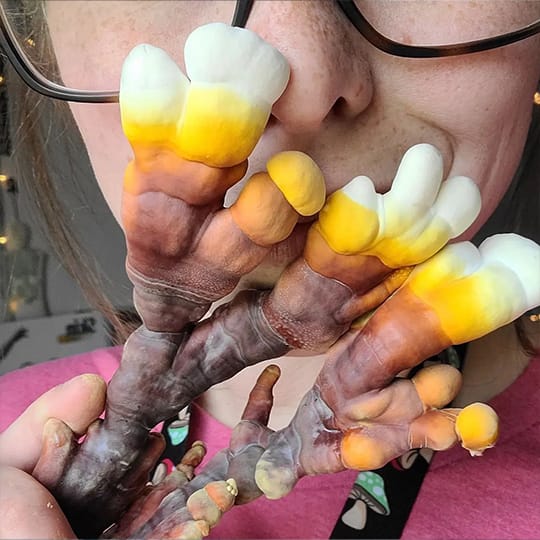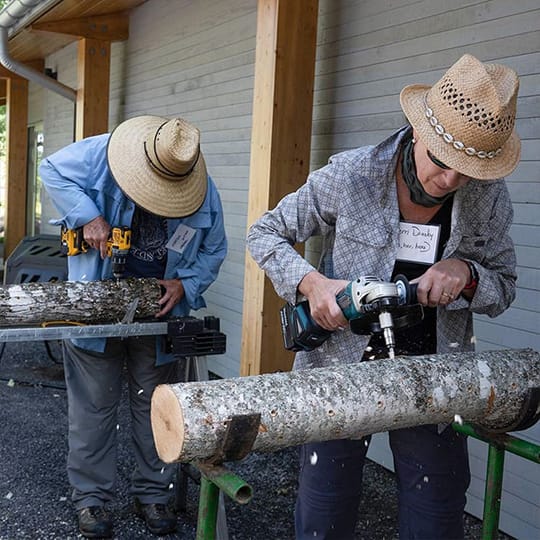











| Skill level | Intermediate |
| Grow location | Indoors |
| Grow speed | 2 to 3 weeks |
| Shelf life | 6 months (refrigerated) |
| Kit dimensions | 6in H x 9in W x 6in D |
| Kit weight | 5 lbs |
| Fruiting temps | 50-65°F |
The North Spore Golden Enoki (Flammulina velutipes) fruiting block features a cultivated strain of Flammulina velutipes prized for its delicate appearance and crisp, savory texture. This strain produces elegant clusters of slender, golden-yellow mushrooms with long, threadlike stems and petite convex caps. When cooked, Golden Enoki mushrooms develop a mild, slightly fruity flavor with subtle umami notes, making them a versatile addition to soups, stir-fries, noodles, and more.
Golden Enoki is a reliable fruiter under cooler temperatures and high humidity, making it an excellent option for growers seeking a unique and rewarding mushroom strain. While a bit more sensitive than oyster varieties, with the right conditions, Golden Enoki will reward you with dense, cascading clusters and has the potential for multiple flushes.
How to Use a Mushroom Fruiting Block Kit
Upon receiving your kit:
Remove the kit from the shipping box as soon as possible. Then, unfold the top of the bag to allow for air space. Make sure the filter patch on the bag is unobstructed to ensure proper airflow—this is essential for the organism to breathe and thrive until you’re ready to fruit your Golden Enoki block.
Scroll down for guides on growing, storage, cooking, and more.
-
CLICK HERE for a full tutorial.
For most mushroom species, including Golden Enoki (Flammulina filiformis), fruiting is triggered by a shift in environmental conditions—specifically increased humidity, access to fresh air (lower CO₂), light, and cooler temperatures.For best results:
We strongly recommend growing your Golden Enoki block in a controlled fruiting environment, such as a monotub or Martha tent. These setups help maintain the cool temperatures and high humidity that Golden Enoki needs to fruit successfully and reduce the risk of contamination.
Creating optimal conditions:
The environmental parameters for Golden Enoki mushrooms can be found on this page under “Temp, Humidity & CO₂ guide” and on page 5 of our fruiting block instruction booklet.
Preparing Your Block:
- Remove the block from the shipping box.
- Unfold and tightly fold back any excess plastic.
- Place the block with the filter patch facing upward.
How to Initiate Fruiting:
- Slice the plastic bag with either a single diagonal cut or an “X” on the top or side—Golden Enoki can be fruited from either surface.
- Mist regularly and maintain high humidity (ideally above 85%) with plenty of fresh air exchange.
Special Considerations for Golden Enoki:
- Golden Enoki requires cooler temperatures to fruit properly—ideally between 50–65°F.
- Lower light levels will produce longer, more traditional enoki-style stems. Increased light may result in thicker stems and pigmented caps.
- Stems are long and delicate—handle with care to avoid breakage.
- Golden Enoki may take 2–3 weeks from initiation to harvest.
Harvesting Your Mushrooms:
Harvest just before the caps begin to expand or flatten. Remove the entire cluster gently to avoid breaking the fragile stems. Note that Golden Enoki has a short shelf life, so consume or preserve shortly after harvesting.
Growing Multiple Blocks Together:
Golden Enoki can be grown alongside other species in a fruiting chamber if you can meet its environmental needs. Prioritize strains with similar cool temperature and low CO₂ tolerance. Humidity requirements generally overlap across species. Don’t be afraid to experiment!
Troubleshooting:
Experiencing stalled growth, abnormal formations, or no pins at all? See pages 16–18 of our fruiting block instruction booklet for guidance and solutions.
-
Temperature 45-65°F | 7-18°C Humidity (Phase 1: Primordia) 98-100% Humidity (Phase 2: Fruitbody) 88-95% CO2 Sensitivity (Phase 1: Primordia) 500-1,000 ppm CO2 Sensitivity (Phase 2: Fruitbody) <1,000 ppm - Primordia - The earliest recognizable stage of fruitbody development. Also known as “baby mushrooms” or “mushroom pins.”
- Fruitbody - A fully grown mushroom, the reproductive structure of the organism in which the spores are produced.
- CO2 sensitivity - When CO2 levels are too high, yields will decrease, stems will become long and stringy, caps will be small, and/or growth will halt.
-
If you don't plan to use immediately, you can refrigerate your block for up to 6 months.
-
CLICK HERE for instructions
Golden Enoki mushrooms have a mild, slightly fruity flavor and a satisfyingly crisp texture when cooked. They're often used in soups, stir-fries, hot pots, and noodle dishes—but they also shine in simple sauté preparations.One of our favorite ways to prepare Golden Enoki is to gently break apart the clusters, trim the root base, and sauté them in butter or oil over medium heat. Add sliced garlic and a handful of fresh herbs like thyme or scallions. Cook just until they soften slightly and the stems remain pleasantly crisp.
For a richer twist, deglaze the pan with a splash of white wine or mirin, reduce briefly, and finish with a drizzle of soy sauce or a touch of cream.
Pro Tips:
- Golden Enoki mushrooms are naturally low in moisture and don’t release much liquid during cooking.
- Avoid overcooking—they’re best when the stems retain their signature crunch.
- Be gentle when handling and prepping—these mushrooms are delicate!
-
If you’re going to consume home-grown mushrooms, make sure to cook your fresh mushrooms thoroughly with heat. If it is your first time eating this species, it is best to start with a small amount to check for allergies, even if cooked.
Mushrooms grow spores as they develop. This is a natural means of reproduction. This is when people with allergies or compromised immune systems may want to consider putting fruiting mushroom kits outdoors or in a well-ventilated area. Spores in mushrooms sometimes cause respiratory irritation. In rare cases, spores may also cause irritation for some non-allergic or non-immunocompromised mushroom growers. If you are one of them, it is recommended to reduce the overall spore load by harvesting mushrooms while they are still in their younger growth stages.
You may also like
Making the world of mushrooms accessible to all
North Spore was launched in 2014 by a mycologist, an organic farmer, and a photojournalist -- three college friends brought together through their shared love of the mycological world.
What began as a simple love for mushroom foraging and cultivation quickly developed into an obsession with all things fungi. From there, an urban mushroom farm was born, as was the desire to spread the spore to the masses.













